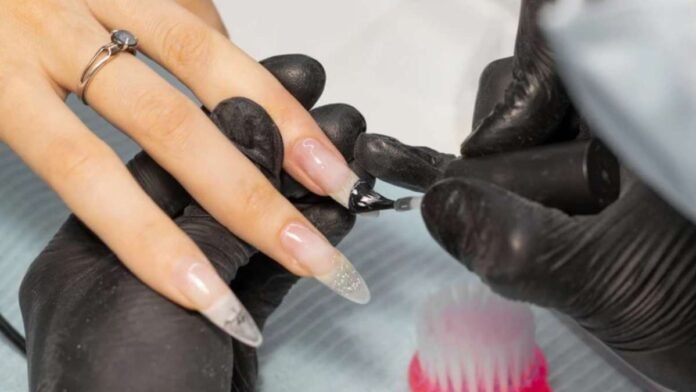Although gel and acrylic nail art may seem lovely, there are unfavourable health risks associated with nails.
Long-term use of gels and acrylics can also result in pseudo-psoriatic nails, in which hyperkeratosis, or additional skin growing under the nail, mimics the red, crusty look of psoriasis. Celebrities, ranging from Rihanna and Kylie Jenner to Cardi B and Ariana Grande, are showcasing their style by wearing long acrylic nails that are frequently heavily adorned with nail art.
Nowadays, the nail fashion market is flourishing, with acrylic and gel manicures being two of the hottest trends. Manicures may seem like self-care, but they can damage natural nails and, in a small percentage of cases, result in unanticipated health issues.
For instance, the adhesive used to affix acrylics to the natural nail usually contains formaldehyde, a known carcinogen, along with alcohol, cyanoacrylate, and photo-bonded methacrylate.
Celebrities, ranging from Rihanna and Kylie Jenner to Cardi B and Ariana Grande, are showcasing their style by wearing long acrylic nails that are frequently heavily adorned with nail art.
Nowadays, the nail fashion market is flourishing, with acrylic and gel manicures being two of the hottest trends. Manicures may seem like self-care, but they can damage natural nails and, in a small percentage of cases, result in unanticipated health issues.
Long-term use of gels and acrylics can also result in pseudo-psoriatic nails, in which hyperkeratosis, or additional skin growing under the nail, mimics the red, crusty look of psoriasis. Many fans of manicures who have pseudo-psoriatic nails have positive methyl methacrylate allergy tests.
Sometimes the allergy might be so bad that it results in irreversible nail loss. Some experience lifelong tingling or numbness in their fingertips due to peripheral neuropathy.
An improbable reason for skin cancer?
Age, skin type, prior exposure, and family history are only a few of the many variables that affect one’s risk for cancer. Nevertheless, there have been incidences of skin cancer when UV nail lamps have been implicated.
Gel nails are cured with specialised dryers that release UVA radiation, an ultra-violet light that hardens the gel and turns it into stiff polymers. Because most individuals get their nails done every few weeks and it takes 10 minutes for them to harden, UVA exposure is greatly increased.
Even though the backs of the hands are among the body’s most UV-resistant areas, they are also left uncovered by clothing and are sometimes overlooked when applying sunscreen. When sunscreen is applied to hands, it is frequently removed with frequent washings without being reapplied.
If you enjoy gels, wear black, fingerless gloves and apply a high-factor sunscreen 30 minutes before your appointment to lower your chance of UV exposure.
Dry, weak, and brittle nails Parts of the nail plate are frequently peeled or shaved away during the removal of gels and acrylics.
The nail’s keratin layers can be harmed by even the most meticulous removal, which can weaken the nail, make it brittle, and cause the damage to appear white (a condition known as pseudoleukonychia).
In addition to drying out the nail and surrounding skin, several removal agents, such as acetone for gel nails, can also enter the bloodstream.
Natural nails can become overfilled during the removal process of both gel and acrylic manicures, leading to alterations and damage to the capillaries beneath the nails as well as stripes extending across their ends.
Bacterial haven Traditional nail varnish is not risk-free either. The amount of oxygen your blood contains is measured by a pulse oximeter, and it can change the readings. Gels, acrylics, and varnish are prohibited in clinical settings because the spaces beneath nails and chips on polish serve as a breeding ground for bacteria that can be transferred between staff members and patients.
Fortunately, most of the time these are not changed to a clinically important degree.
If you’re the kind of person who loves getting their nails done, it might be best to avoid gels and acrylics and instead focus on taking care of your natural nails. Keep them visible so you can spot any changes in their look that could point to health problems, such as fungal infections or even heart disease.




